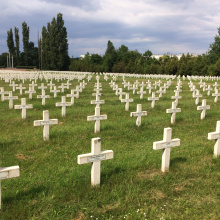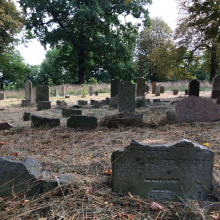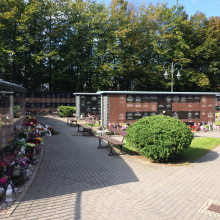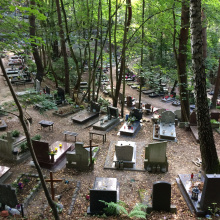Dr Beata Czechowska-Derkacz talks about new and traditional forms of burial and cemetery design with mgr Krystian Puzdrakiewicz from the Institute of Socio-Economic Geography and Spatial Management of the Faculty of Social Sciences at the University of Gdansk.
November is a time when we talk about death in the context of spirituality, religion and philosophy. But I would like to talk about the more tangible aspects of this topic - cemeteries and forms of burial. You do research in this area. What changes are we facing?
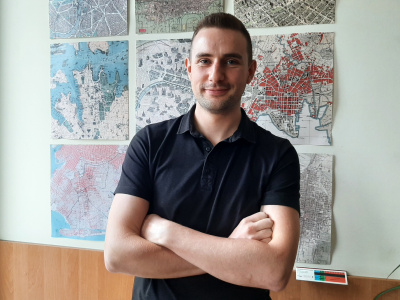
mgr Krystian Puzdrakiewicz
- Across cultures and religions, the body of the deceased is seen in the realm of the sacred and has great value, and each type of burial has one main purpose - to commemorate the deceased. The rituals associated with burial have changed and continue to change, but when we talk about the form of burial, it does not generally change significantly. The most common is the burial of the body of the deceased, the so-called traditional earth burial, or cremation. Relatively new practices for dealing with the bodies of the deceased are composting, a process in which the body is placed in a special box and is transformed into natural compost and then issued to the family for use, or resomation, the dissolution of the body in a potassium hydroxide solution, which requires several times less energy than the familiar incineration process. Forest cemeteries are emerging, without traditional headstones and using biodegradable urns. New technologies are being used to develop more ecological and economical ways of dealing with the bodies of the dead. We handle them in different ways, but it is still important that a trace is left of someone, usually in the form of a monument or an epitaph. A completely new model is virtual cemeteries - transcendent cemeteries, where it is not the physical location of the grave that is important, but the remembrance and enabling of the commemoration in an immaterial form, and therefore accessible almost anywhere on a smartphone screen. This solution is becoming more and more common, for example in China. In Poland, such a cemetery also exists and can be easily found online, which I encourage you to do, as probably not many people have heard of it.
- Could we say something more about burial traditions?
- All burial practices reflect society's attitude to death and the dead. Cemeteries and the traditions associated with them tell us more about generations of the living. In ancient times, the dead were feared, so they were buried away from settlements so that the spirits would not disturb the living. In the Middle Ages, there was a certain blurring of temporal and eternal life. The dead were buried within church walls, often under the church floor or in church graveyards. At the beginning of the 19th century, mainly for sanitary reasons, the space of the living and the dead was separated by moving cemeteries outside the city walls. These, however, with the growth of cities, have in many cases been absorbed into their current fabric and we have a renewed, though not necessarily intended rapprochement. Old regional traditions are still alive in various regions, not only in Poland. For example, it is practised to leave the body of the deceased at home for a few days so that we can say goodbye to them and perform traditional rituals. We still have beautiful historic cemeteries, you can see monuments in the shape of angels or saints, and we encounter very personal epitaphs dedicated to the deceased. In the past, the rituals and traditions associated with a funeral were approached much more individually, and more time was spent on them. Today, we tend towards simplification. We live in a global world, so burial forms and cemeteries are also globalising. The market for funeral services is commercialised and quite similar everywhere. There are funeral homes that offer specific services, although depending on their funds, sometimes very fancy ones.
- I would even say that there are all sorts of fashions. In the context of funeral services, does the cemetery remain a sacred space?
- First of all, we decide this when we visit cemeteries, and as long as we treat their space in a special way, they will remain a sphere of the sacred. It is not entirely tangible, felt primarily intuitively, but we have symbols that allow us to identify this space in this way. It is, for example, the gate we have to cross in order to enter the cemetery, the wall or fence that separates the zones of the sacred and the profane. The gate - sometimes beautiful and superfluous, and sometimes contemporary and simple - has a practical function at the same time, just like a wall or a fence. At cemeteries, we plant specific vegetation, in Poland for example weeping willows, which are meant to remind us of sadness, of transience. The idea behind these various treatments is to evoke nostalgia and respect for the dead.
- Is cemetery design a separate art? Are there special guidelines?
- A cemetery should be designed as a park-like setting - a green area. Spatial layouts are designed with scenic axes and greenery. How a cemetery is designed can be an expression of social traditions, but also contemporary preferences and expectations. For example, in the more prominent places in the cemetery, with good accessibility, along the main avenue, plots for traditional forms of burial are usually placed and these are considered the most prestigious places. However, columbaria or urn fields can also be designed there to encourage cremation, which from the point of view of cemetery management is a more desirable, less area-intensive form. The cemetery, which is intended to create a harmonious space aesthetically and functionally, should be designed so that it can grow in a controlled way with the addition of new zones, it should have a variety of separate burial plots as well as common spaces to serve visitors that do not create the impression of chaos. Today, soundscape, or soundscape, plays a major role in cemetery design. The idea is that they should be quiet to allow for reflection, so that noisy cars or factories cannot be heard. A well-designed cemetery can be a beautiful space to visit and spend time in.
- Do we have such architectural pearls in Poland as the Pere-Lachaise cemetery in Paris? I ask because I was there and spent a beautiful summer day there, which I remember more as a time combined with reflection, tranquillity and slow visits rather than a cemetery tour.
- A few months ago, I went to the Pere-Lachaise and Montmartre cemeteries. Parisian cemeteries are particularly beautiful places and are widely described in literature. Such exceptional places in Poland include, for example, the Powązki cemetery in Warsaw or the Pęksowy Brzyzek cemetery in Zakopane. The Central Cemetery in Szczecin has a beautiful, harmonious layout. In general, all historic cemeteries that have a closed form are interesting. Just walking through old cemeteries which have a history and famous dead, allows you to spend even a few hours there and listen to stories not only about the cemetery itself but also about society, changes, what happened in the city, why someone ended up here, whether they were born or migrated here, for what reasons. In contrast, such ordinary, contemporary cemeteries are often chaotic, strictly designed for burials with no formed composition and, in my opinion, their aesthetic value is very questionable. Ever since I started doing research related to the management of cemeteries and their public perception, every trip I make is related to visiting burial sites. I also recommend this form of tourism to my friends, who are beginning to see something interesting in cemeteries and not just repulsive. Sometimes I get photos of cemeteries from their trips and they are very original places, such as the cemetery on a beach in Tenerife.
- Is so-called cemetery tourism popular?
- The scientist who described this phenomenon in Poland was Sławoj Tanaś and he used the term 'thanatological tourism'. But it is not a very popular form of visiting - tourists tend to go to city centres and typical attractions. Unless, of course, we are dealing with a place as special as the aforementioned Pere-Lachaise cemetery. However, there are guided tours, also in Gdańsk, where you can walk through a cemetery and listen to many interesting stories. It is said that a single grave is an anchor of memory and a testimony to the existence of a person or a family. A cemetery, on the other hand, is a testimony to a whole society. If we want to find out something interesting about a particular historical period, it is very often in the cemetery that the various threads become intertwined. A lot of information is provided by gravestones, which used to be more personalised. Even the profession of the deceased was written on them, which is hardly the case nowadays, and we can sometimes only find an academic title or military rank written next to the name. The cemetery opens up a whole range of different themes: social, economic, legal or environmental. I have taken part in such guided cemetery tours several times and I also take my friends there.
- What is the most unconventional cemetery you have seen somewhere in the world?
- I haven't seen one, but I would love to get to a vertical cemetery, which resembles a skyscraper. It is built like a popular office building, only that each floor has niches for coffins or urns, and earth graves are only possible on the lowest floor, where the whole structure stands on columns. This form can be found in Latin America and has been forced by spatial pressures, as cities do not have enough space to develop and so a search is being made for how to provide space for both settlements and cemeteries. The solution offers multistoried cemeteries, but although it is an interesting idea, in Europe it can be considered controversial and I have not heard of attempts to build such cemeteries, despite emerging architectural ideas. The forest cemeteries in Sweden or Germany that I have seen recently are very interesting. They look like an ordinary forest, as the cemetery has actually 'entered' the forest. There are tiny plaques on trees under which someone has been buried after cremation in a biodegradable urn. In the Swedish case, stones with epitaphs are used instead of plaques. These are plain, uncut and non-geometric field blocks on which the name, surname and dates are inscribed. The intention is for these natural monuments to be inconspicuous, to blend in with nature, and for the cemetery to look like an ordinary forest, with the difference that we find traces of the dead in it.
- It is a very beautiful idea, but are we as Poles, so attached to traditional forms of burial and cemeteries, ready for such new solutions?
- According to Polish law, there is nothing to prevent such a cemetery from appearing. The law regulating the creation and operation of cemeteries in Poland dates back to 1959. However, the changes it introduced mainly concerned administrative issues, leaving aside a catalogue of possible forms of burial. When planning the establishment of a cemetery, it is required that the area is fenced, must receive a positive opinion from the sanitary inspector and its designation must be in accordance with the local zoning plan. As a society, we are only just coming to terms with new solutions regarding burial forms and cemeteries. Solutions are indeed being introduced around the world - in the USA, for example, the fifth state in a row has already recognised body composting as a legal form - but in Poland, the discussion on new forms of burial is so far barely audible, almost absent. Cremation began to develop in a real way in Poland at the beginning of the 21st century, while columbaria were still almost invisible in our cemeteries twenty years ago and there are still not many people willing to bury the ashes of their loved ones there. However, it should also be noted that columbaria are already starting to become a permanent feature of Polish cemeteries and do not arouse as much emotion as they once did. In 2004, the level of cremation in Poland was 4%, currently, it is estimated at more than 30%, but in the largest Polish cities with more than 250 000 inhabitants, it is already 49% on average. With that said, the majority of urns go into earthen graves in the form of interment in existing graves. However, it is not possible to keep urns at home or anywhere else; any burial must take place at a cemetery. We cannot legally scatter ashes, as in the memorial fields popular in Sweden. Such places could be created in Poland, as it would not be a great difficulty to set aside a suitable place in a cemetery. It seems that the law has not kept up with the mental changes in terms of new forms of burial and cemeteries, but in my opinion, the discussion on this topic is not to the liking of any ruling faction, as it is socially difficult and may cause a lot of controversies.
- Are new forms of burial, including those considered controversial, being forced by the situation of overpopulation in the world? Do we still have room for traditional cemeteries?
- We are definitely being forced by the situation of increasing urbanisation of space, overpopulation of cities and, more broadly, climate change. There is not enough space for large cemeteries with traditional burials. Despite the inviolability attributed to cemeteries thanks to the sacred, there are many examples in history of their closure. One only has to go back to the time after the Second World War and the migration of the population, which resulted in the abandonment of ancestral graves, which fell into oblivion and were devastated. In addition, in Gdańsk, among other places, many of the graves were German and were therefore seen as enemy cemeteries. Few of these were interrupted. Nowadays we are at a point where we would like to preserve the cemeteries we already have, no matter what condition they are in because we consider them as our heritage, a testimony to history. But at the same time, cities are growing and existing cemeteries will quickly fill up. There is a shortage of good locations. Everyone would like to have a cemetery close by, but not enough to live next door, in the neighbourhood. I have carried out research in eleven of the largest Polish cities and, as the results show, none of them are planning to liquidate cemeteries. And so far, even though cities face many problems in ensuring the supply of free burial places, they can provide them. New forms of burial, such as the aforementioned resomation or body composting, are solutions, facilitating the provision of space for future cemeteries because they require less or no space at all, possibly as a memorial without deposited remains. In researching the development of cemeteries and burial forms, three stages can be distinguished. The first is a kind of competition between the living and the dead for space - disputes over whether to plan an area for a housing estate or a cemetery. The second stage is the compression of space, i.e. the intensive use of cemetery space, which is made possible by, among other things, cremation and resomation using columbaria or multiple interments in earthen graves. The third stage is transcendence, a decline in the importance of the physical burial site but the preservation of the deceased in memory - the ashes of deceased loved ones are scattered in memorial fields or we use virtual cemeteries. But each form of burial generates some problems, for example, cremation requires a lot of energy and emits pollution. It is also worth discussing the life cycle of cemeteries. Perhaps instead of prolonging the graves of ancestors indefinitely, it is worth using this space for future generations. In Indonesia, you can see tombs shaped like small houses, located next to houses. On the lower level, there are niches where the bodies of the recently deceased are deposited, after a few years, the coffins are moved to a higher level until finally the remains are placed on the very top, where there is one small place set aside for past generations. In this way, the whole family is buried in one place.
- Your research encompasses public attitudes to the idea of the cemetery as a park and at the same time as a recreational area where various activities are possible. Are we ready for such changes?
- My research and fascination with this topic started at Assistens Cemetery in Copenhagen, where Hans Christian Andersen, among others, is buried. We sat down with a group of friends right next to his monument to have a second breakfast. There was nothing inappropriate about this behaviour, as Danish cemeteries are used as a recreational areas at the same time. There are fewer graves and more green space and many people spend their leisure time there. Cemeteries are green areas and public spaces at the same time. Polish cemeteries mostly don't look like this, we see mostly tombstones and crosses dominating the landscape. There is some greenery, and even quite a lot in old cemeteries, but they usually do not resemble an urban park. The main function of a cemetery will always remain to visit the graves of the dead, but various forms of recreation can be introduced at the same time, although these can be debatable or controversial. Of the most surprising examples documented in Western countries, I can mention the screening of horror films in an old cemetery, the organisation of Halloween events, a concert of classical music, jazz and rock or even an exhibition of vintage cars. In one cemetery in Sweden, a church is formed out of greenery - out of trees and bushes. In the middle is an alley with benches that leads to an altar where weddings are performed. The cemetery becomes a symbolic place of the end and the beginning. I began to wonder whether Polish cemeteries had a chance to look different and whether there would be space to discuss expanding their functions. It is true that the cremation rate is increasing in Poland, but not enough to make the situation look like, for example, cemeteries in Switzerland, where old traditional graves are slowly disappearing and cemeteries are freeing up green space. I have prepared a survey on the social acceptance of the use of Gdańsk cemeteries for recreational purposes. I am curious to know whether it would really bother us so much if we encountered people cycling, jogging or walking their dogs on a leash in the cemeteries. Whether the fact that we do not use the cemetery space in this way is really the result of our deep convictions or the result of formal prohibitions. To what extent are these traditions ingrained and are we ready for change? I'm going to ask about different activities, but ones that seem more easily accepted, as we are hardly ready for horror shows. There are also novelties like QR codes on monuments. Such an idea came up in the US and the idea was to be able to see a presentation about the deceased or maybe even a speech prepared by the deceased, but at the same time, a debate erupted about whether a cemetery is a place to run around with a phone between graves, scanning codes and watching videos. The survey will be limited to residents who live close to cemeteries, as no one is likely to specifically drive to, say, the Łostowicki cemetery to run there. But if it is often the only nearby green space, I am curious to know if residents would also like to use it as a place for active recreation. The study also covers the post-cemetery parks in Gdańsk, because the study conducted earlier shows that the liquidation of the cemetery does not completely deprive the area of its sacred value. There are no longer any traces of graves there, and the former cemetery function is indicated mainly by the layouts of the avenues of trees or the monument, which reminds us of the unique history of the place. But many people believe that these are not ordinary parks and should remain a zone of tranquillity out of respect for the dead who were once buried there. In a survey, I asked whether the cemetery should be converted into a park following the decision to decommission it. The vast majority of people were positive about such a solution, but the placement of dog runs, playgrounds or a gym there already elicited negative reactions. Even in the 1960s, when cemeteries were transformed into parks near what is now the Gdańsk University of Technology, playgrounds were not located there to pay respect to those who had once been buried there. However, we do have examples of such infrastructure in several of Gdańsk's post-cemetery parks. I intend to carry out 650 face-to-face questionnaire interviews with residents and I hope that the results will allow us to assess how ready we are for change. Above all, because Gdańsk is currently in a special situation. Only the Łostowicki Cemetery, thanks to the recent expansion of the area, will have space for new traditional burials for the next three years or so. There are plans to extend the Srebrzysko or Garrison Cemetery, and the city is considering where to locate a new cemetery. This is a good time to see if we are ready at all, and what changes we are ready for so that while we solve the problem of providing burial places, we also ensure the need for access to public green spaces. I am not a great optimist, but I am hoping that this survey will start a discussion on the subject and maybe even bring surprising conclusions. The results should be out as early as November this year.
- So I'm waiting with curiosity, and in conclusion, I'd like to ask you which of Gdańsk's cemeteries would you take people on November 1 who don't have their loved ones here?
- There are three such places. I would first go to the Garrison Cemetery. It has a long history and nice historical monuments with old epitaphs. There are a lot of contrasts there - the dead lying there were on two sides of the barricade during the war. For example, a person who escaped from a concentration camp lies next to a German soldier. From there I would move on to the Cemetery of Non-Existent Cemeteries in Gdańsk, which has an interesting form, but above all an idea. In 2002, a campaign was started in Gdańsk to find and remember cemeteries that no longer exist, and in the following years, commemorative monuments were set up in some of the cemetery parks. A few years ago, the Nostalgic Park was created on the site of the former forest urn cemetery on Mount Gallows in Wrzeszcz. Throughout Gdańsk's history, 101 cemeteries are recorded, a quarter of which still survive today. And finally, I would visit Srebrzysko Cemetery, whose main avenue is located in a valley, which especially on November 1 after dusk looks exceptionally beautiful and atmospheric.
- Thank you for the interview.

